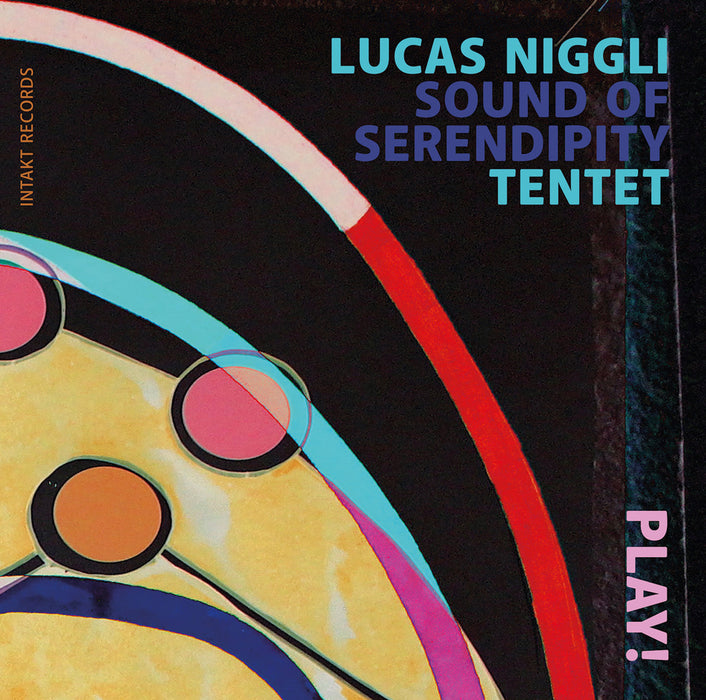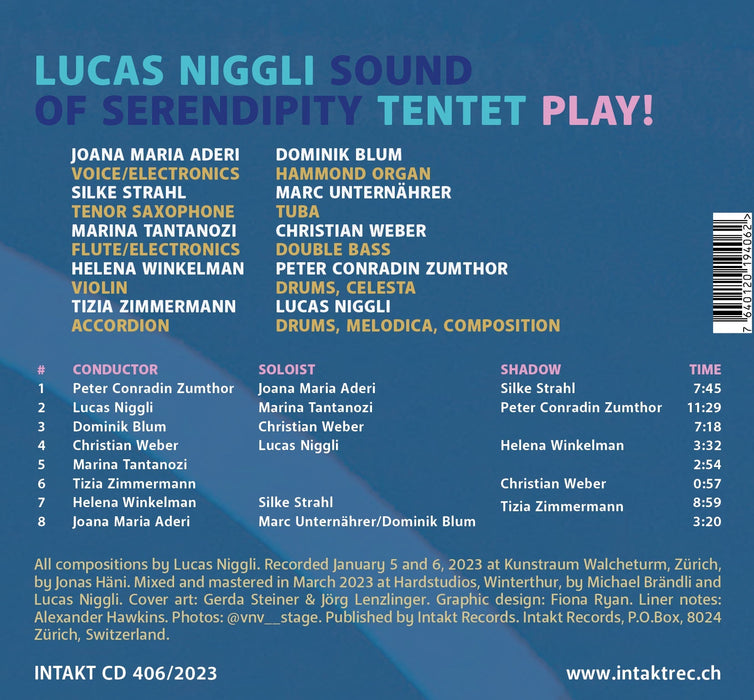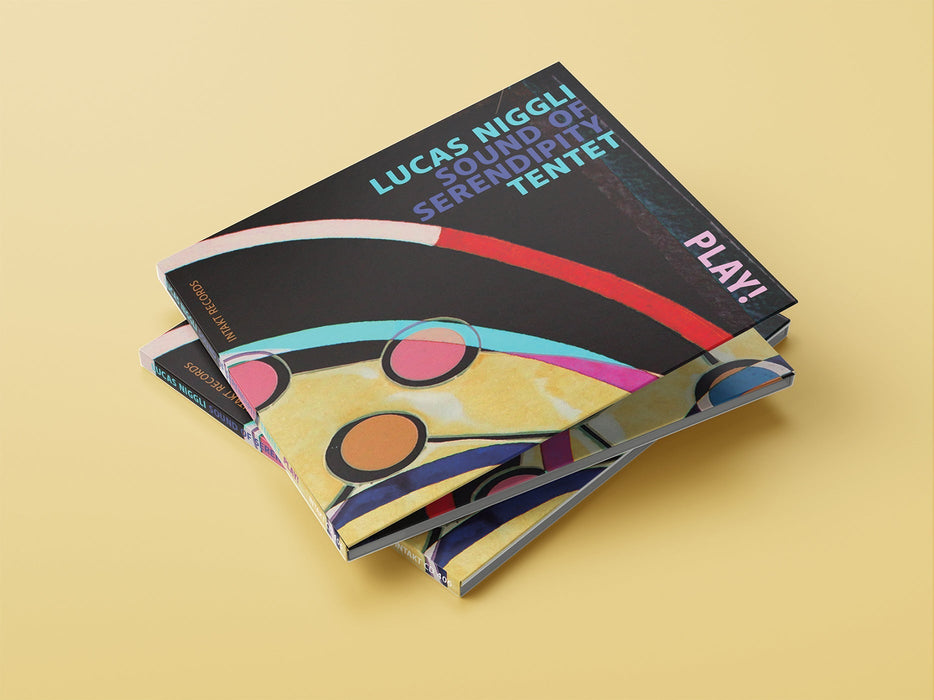


406: LUCAS NIGGLI SOUND OF SERENDIPITY TENTET. Play!
Intakt Recording #406 / 2023
Joana Maria Aderi: Voice / Electronics
Dominik Blum: Hammond Organ
Silke Strahl: Tenor Saxophone
Marc Unternährer: Tuba
Marina Tantanozi: Flute / Electronics
Christian Weber: Double Bass
Helena Winkelman: Violin
Peter Conradin Zumthor: Drums, Celesta
Tizia Zimmermann: Accordion
Lucas Niggli: Drums, Melodica, Composition
More Info
Mit dem Sound Of Serendipity Tentet versammelt der seit vielen Jahren zur Spitze des europäischen Jazz gehörende Lucas Niggli einige der spannendsten Musiker*innen der schweiz-europäischen Jazz- und Improvisations-Szene. In einer höchst eigenen Spielanweisung via 40 komponierten Spielkarten, umgesetzt von diesem zehnköpfigen Ensemble von starken Persönlichkeiten und dem Faktor Zufall, entsteht mitreissende Musik. Play! ist ein Vehikel, um das Spektrum von komponiertem und improvisiertem Verhalten in der Form eines Kartenspiels zu verhandeln. «Auf der einen Seite hören wir eine Komposition, die wie eine Erweiterung des musikalischen Charakters von Lucas Niggli klingt: quecksilbrig, sehr detailliert, unheimlich empfänglich für andere, ohne Angst vor Groove. Andererseits vermute ich, dass das Publikum, das mit den einzelnen Interpret*innen der Aufnahme vertraut ist, darüber schmunzeln wird, wie lebendig die individuellen Eigenschaften dieser Interpret*innen durch Nigglis Spiel in Szene gesetzt werden», schreibt Alexander Hawkins in den Liner Notes.
Album Credits
Cover art: Gerda Steiner & Jörg Lenzlinger
Graphic design: Fiona Ryan
Liner notes: Alexander Hawkins
Photos: @vnv__stage
All compositions by Lucas Niggli. Recorded January 5 and 6, 2023 at Kunstraum Walcheturm, Zurich, by Jonas Häni. Mixed and mastered in March 2023 at Hardstudios, Winterthur by Michael Brändli and Lucas Niggli.
More than a game piece that creates musical situations suggested by the shuffling of playing cards into three-fold suits, Swiss percussionist Lucas Niggli’s refined this eight track program so that tentet members negate any breach between composition and improvisation. Although different conductors, soloists and backing players are listed for each piece, foreground and background roles aren’t static.
Niggli, whose experience encompasses solo sets, a punk-jazz trio and African percussion experiments, only lightly sprinkles rhythmic strokes and slaps among the tunes from his kit and drummer Peter Conradin Zumthor’s. Instead the tracks’ contours are decided by soloist juxtaposition, as extended technique alters expected sounds. “Movement 2” for instance evolves from Marina Tantanozi’s electronically doubled flute puffs and shrills to near opaque vibrating textures from organist Dominik Blum and accordionist Tizia Zimmermann then reinstates flute peeps mated with squeeze box jerks. The most natural transition between dissonance and delicacy occurs with “Movement 4” and “Movement 5”. Joana Maria Aderi’s voltage-altered vocals paired with percussion clangs cushioned by Marc Unternährer’s tuba ostinato subsequently turns into a brief pastoral flute feature.
While space is also made for aggressive altissimo asides by tenor saxophonist Silke Strah and stentorian slaps from bassist Christian Webber as well as widely separated rock-like or marching-band-like interludes, the suite’s basic structure remains constant and linear.
Not only does the group Play exceptionally, but it also demonstrates how to play using varied sound elements while preserving a coherent musical perception.
https://www.jazzword.com/reviews/lucas-niggli-sound-of-serendipity-tentet/
More than a game piece that creates musical situations suggested by the shuffling of playing cards into three-fold suits, Swiss percussionist Lucas Niggli's refined this eight-track program so that tentet members negate any breach between composition and improvisation. Although different conductors, soloists and backing players are listed for each piece, foreground and background roles aren't static.
PLAY!
Niggli, whose experience encompasses solo sets, a punk-jazz trio and African percussion experiments, only lightly sprinkles rhythmic strokes and slaps among the tunes from his kit and drummer Peter Conradin Zumthor's. Instead the tracks' contours are decided by soloist juxtaposition, as extended technique alters expected sounds. Movement 2 for instance evolves from Marina Tantanozi's electronically doubled flute puffs and shrills to near opaque vibrating textures from organist Dominik Blum and accordionist Tizia Zimmermann, then reinstates flute peeps mated with squeeze box jerks. The most natural transition between dissonance and delicacy occurs with Movement 4 and Movement 5. Joana Maria Aderi's voltage-altered vocals paired with percussion clangs cushioned by Marc Unternährer's tuba ostinato subsequently turns into a brief pastoral flute feature.
While space is also made for aggressive altissimo asides by tenor saxophonist Silke Strah and stentorian slaps from bassist Christian Webber, as well as widely separated rock-like or marching-band-like interludes, the suite's basic structure remains constant and linear.
Not only does the group Play exceptionally, but it also demonstrates how to play using varied sound elements while preserving a coherent musical perception.
https://www.thewholenote.com/index.php/booksrecords2/jazzaimprovised/33218-play-lucas-niggli-sound-of-serendipity-tentet
Lucas Niggli Sound Of Seren- dipity Tentet Play! • Cd Intakt • 8t-46:18 Un game piece del tutto peculiare. Le carte date ai musicisti sono di quattro tipi: ritmiche tematiche, soniche e di colore. All'interno di re- e gole prestabilite la libertà degli interpreti è massima, con il ruolo del conductor che ruota. Nel nutrito ensemble (sax tenore, flauto, elet- tronica, violino, fisarmonica, Ham- mond, tuba, contrabbasso, due bat-terie, celesta e melodica) ci piace segnalare la presenza di Joana Maria Aderi a voce ed electronics, già nei Phall Fatale con il compianto Fredy Studer. Il mood è febbrile, selvatico, elettrico, l'interplay ser-rato, l'ispirazione sempre a fuoco. StrikeR
À partir de quarante cartes à jouer portant chacune une composition, un tirage en trois tours permet de créer un ensemble de jeux instrumentaux inédits faisant également appel à l’improvisation. Ce principe, qui a pour but de provoquer des interactions inattendues, comporte une part de risque, comme tout jeu de hasard.
En dépit de cette construction orchestrale originale, l’orchestre de Lucas Niggli n’arrive pas à trouver un équilibre structurel. Les compositions sont toutes peaufinées dans les moindres détails, les instrumentistes sont impliqués mais la musique peine à décoller. L’héritage historique des grands ensembles issus du free jazz a influencé nombre d’improvisateurs, mais innover n’est pas toujours chose aisée.
Le « Premier Mouvement » se déroule en variations sans cesse renouvelées. La voix, soutenue par des rythmes binaires, ne parvient pas à faire naître l’emballement prévu qui aurait pu être spectaculaire : la musique est comme stoppée dans son processus. Le « Quatrième Mouvement » se cherche sans atteindre une expressivité convaincante ; il est difficile d’y percevoir une ligne directrice. Il y a du bon malgré tout dans le « Troisième Mouvement » où transparaît la personnalité de Lucas Niggli, un des grands improvisateurs helvétiques. La direction d’orchestre, assurée par Dominik Blum, permet à Christian Weber de prendre un beau solo à la contrebasse. Helena Winkelman conduit un « Septième Mouvement » très convaincant où la masse devient lisible et s’enrichit d’un solo magistral de Silke Strahl au saxophone ténor.
Il est dommage que Play ! n’offre pas une unité orchestrale constante, mais son concept artistique demeure particulièrement hasardeux. Cette expérience musicale désirée et mise en pratique par Lucas Niggli démontre cependant qu’il ne reste pas les deux pieds dans les mêmes sabots.
P.S. : Joana Maria Aderi (voc, electronics), Dominik Blum (org), Silke Strahl (ts), Marc Unternährer (tu), Marina Tantanozi (fl, electronics), Christian Weber (b), Helena Winkelman (vln), Peter Conradin Zumthor (dm, celesta), Tizia Zimmermann (acc), Lucas Niggli (dm, melodica, comp)
https://www.citizenjazz.com/Lucas-Niggli-Sound-Of-Serendipity-Tentet.html
Che cosa lega assieme dieci dischi che, con tutte le approssimazioni per difetto del caso, rappresentano per chi li indica un po’ il meglio dell'anno che va a chiudersi?
Apparentemente nulla, se si va oltre il comodo recinto dei “generi” dove il rischio di confondersi è minimo, visto che si premiano le proprie certezze. Allora il senso qui sarà un altro: scegliere – dopo un riascolto attento e in rigoroso ordine alfabetico – le cose che hanno regalato emozioni intense, dato da pensare, confermato quanta strada c’è appena dietro di noi e quanta è possibile percorrerne con buona dotazione, in alternanza, di memoria e di visionarietà.
Può esistere un ragionevole compromesso tra le ragioni dell’impro radicale e il lirismo acceso, il caso e la presa salda sull’architettura sonora? Sicuro, s’è c’è di mezzo un gruppo così. Un mazzo di carte estratte a sorte con indicazione: “ritmica”, “motivico”, “Sonica” “Colore”, otto direttori che si alternano nel tentet alla conduction, a rotazione, così come i solisti (magnifico Marc Unternährer alla tuba), strutturando la casualità e la sequenza di indicazioni delle carte con un rigore, diremmo, gioioso.
https://www.giornaledellamusica.it/articoli/i-10-migliori-album-del-2023-di-guido-festinese
Finden, ohne zu suchen. Das Phänomen „Serendipity" beschäftigt Lucas Niggli, international als spielfreudiger, humorvoller, kreativer und mit seinen Projekten immer wieder überraschender Drummer bekannt, schon lange. u hast irgendwo tief in deinem Unbewussten eine innere Bereit-schaft, um schöne Dinge nicht zu verpassen, ohne dass du dich aktiv darum bemühst." Und so wurde Lucas zum „Spieleentwick-ler", weil ein Kompositionsauftrag für das Basler Ensemble Phoenix zu ihm gekommen war. Da er für dieses erfahrene Ensemble etwas Neues schaffen wollte, kam ihm die Idee mit dem Kartenspiel. Er entwarf je 9 „komponierte Karten mit Rhythmen, Melodien, Texturen und Farben sowie Spezialkarten für Dirigent:in (diese Rolle wechselt zwingend in jeder Runde), Solist:in, Schatten (diese Figur kann ein musikalisches Ereignis, das ihr besonders gefällt oder zu wenig im Fokus ist, verstärken). Da die Musiker:innen in den drei Runden zu je 15 Minuten jeweils nur eine Karte sowie eventuell eine Spezialkarte verdeckt erhalten, ist das Konzert zwar an Regeln gebunden und doch frei. der interessantesten Persönlichkeiten der Schweizer Musikszene, um das Konzept mit seiner eigenen „selection of crazy characters" umzu-setzen. Die außergewöhnliche Vielseitigkeit der Musiker:innen, das tiefe gegenseitige Vertrauen, Spielfreude und Konzentration eröffnen immer neue Kosmen: tänzerisch, groovig-funkig, volkstümlich, afri-kanisch, witzig, höfisch, leise, verzweifelt, kreischend, flirrend, grummelnd. sirenenhaft. pfauchend. anarchisch... Dass das daraus abgeleitete Album „Play!" kein Live-Mitschnitt ist, sondern eine Art Best-Of aus vier Konzerten, war eine bewusste Entscheidung: straf-fen, zum Kern vordringen und dadurch Neues schaffen. Neues entsteht gerade auch für die NDR Ruhr-Triennale: ein Stück für Bigband und Symphonieorchester. Man darf gespannt sein, was Lucas noch finden wird, ohne zu suchen.
Who doesn’t love games? For this 46-minute piece, divided into eight movements, drummer/ composer Lucas Niggli created a collection of 40 playing cards that he distributed among 10 players from the Swiss jazz and improv scene. The three-round “game” was played over the course of two days in January 2023. Here’s the problem, though: This CD doesn’t come with a deck of cards, closing off a potentially fruitful avenue of interpretation. (Yes, music created in response to graphic or otherwise unorthodox scores should be packaged with those scores.) The listener is left with nothing but the music. And based solely on the sounds, one would be hard-pressed not to think of this as Joana Maria Aderi’s album, as her voice and electronics are quite prominent throughout; she seems to be operating in the tradition of avant-garde artists fascinated by language and the voice, like Laurie Anderson. Other players who make a strong showing are accordionist Tizia Zimmermann and Hammond organ player Dominik Blum; on the final movement of Play!, Blum rises to peaks of ecstasy reminiscent of Deep Purple’s Jon Lord. Some of the sudden transitions and mildly kitschy vignettes may remind listeners with long memories of John Zorn’s game pieces, but there are some diverting combinations of sounds. On “Movement 2,” Marina Tantanozi’s flute skitters and whirls above pulsing electronics and Christian Weber’s thumping upright bass, eventually joined by shrill stabs from Helena Winkelman’s violin. However this music was created and realized, it’s more interesting than not.
LUCAS NIGGLI SOUND OF SERENDIPITY TENTET play!
Intakt
Lucas Niggli (dr, melodica), Joana Maria Aderi (voc, e), Dominik Blum (hamm-org), Silke Strahl (ts), Marc Unternährer (tuba), Marina Tantanozi (fl, e), Christian Weber (b), Helena Winkelman (v), Peter Conradin Zumthor (dr), Tizia
Zimmermann (akk)
Lucas Niggli hat neun Musikerinnen zu acht Spielrunden eingeladen (logischerweise ohne Gewinner:in am Ende). An der ersten Spielrunde durfte im Züricher Kunstraum Walcheturm auch das Publikum teilnehmen. So wurde ermittelt, wer dirigiert, wer soliert und wer im sogenannten Schatten der Solierenden agiert. Die acht Kompositionen wurden auch abwechselnd, demokratisch von acht unterschiedlichen Musiker:innen dirigiert. Rätselhaft wird es, wenn der Schatten ohne Solist:in spielt oder keiner von beiden. Die Rollen sowie die Kompositionen und musikalischen Kategorien wurden mittels eigens gestalteten Spielkarten zugeteilt. Gerne hätte man selbige dem Album auch beigelegt erhalten, zumindest aber gesehen. Man mag sich an John Zorn oder Butch Morris erinnern, zum Glück fällt Nigglis Projekt nicht so tierisch ernst aus wie diverse Conductions oder Cobra-Projekte. Leider lenken die Spielregeln, die man nicht wirklich durchschaut, vom eigentlichen, durchaus vergnüglichen Hören ab. Niggli präsentiert letztlich eine feine, schräge Bigband am Puls der Zeit. Wie viel Probenarbeit und Können hinter dieser Produktion stehen, kann man freilich nur erahnen. Der elfte Mitspieler, der Zufall, zeigt, wie gut eingespielt Nigglis Ensemble sein muss, um schnell zugeteilte Rollen und Aufträge in diesem Spiel zu erfüllen. Alexander Hawkins dazu im Booklet: „Der Weg ist das Ziel. Das Besondere an diesem Album ist aber auch, dass man die Musik hören kann, ohne sich über den Entstehungsprozess den geringsten Gedanken zu machen." (ws)
Lucas Niggli Sound Of Serendipity Tentet
Play!
Intakt
Plaats “enfant terrible” uit de Europese impro scene Lucas Niggli op een podium samen met negen gelijkgestemde beeldenstormers en je krijgt een orgie van impressies.
Hels, heftig, chaos, vervorming, ontregeling en kosmische horror zijn slechts enkele termen die deze intrigerende “wall of sound” omschrijven. Maar ook stilte en rustpunten behoren tot het scenario. Kortom, een typisch Lucas Niggli opname.
De drummer reikte de blauwdrukken aan maar elk “thema” (gekozen volgens toeval uit een kaartenspel) wordt afwisselend geleid door een andere muzikant. Met verhelderende “liner notes” van Alexander Hawkins.
Megalomane stijloefening of meesterlijk controversieel luisterspel? We gaan voor het laatste.
https://www.jazzhalo.be/reviews/cdlpk7-reviews/various/la-rentr%C3%A9e/
The ambiguity of the term "serendipity" perfectly sums up what this sums up perfectly what this by the active Swiss composer composer and percussionist Lucas Niggli is about: the sense project initiated by Lucas Niggli: the intuition of to bring about a fortunate coincidence, or, in the musical context, from guided improvisations (open) compositions from guided improvisations. open) compositions. "Playl" is a card game that allows the the instrumentalists of the tentet at certain the instrumentalists of the tentet at certain sequences, rhythms or sound events rhythms or sound events, within which the within which the performers can take certain liberties. can exercise certain freedoms. For each piece there are changing "Conduc- tors" for the tors" for the allocation of cards and and "Shadows" with the task of under- the task of supporting what is as well as soloists with all the all freedom of decision. As with comparable "game pieces" (e.g. John Zorn's "Cob- ra"), "the way to the goal", as the goal", as Alexander Hawkins writes in writes in the liner notes. And of course it is exciting and interesting to hear the reteiligton in following the rules, and reacting to the rules. and reacting. But, Hawkins continues, what makes what makes Niggli's "Play!" a successful album? a successful album, is the fact that, as an ad hoc composition even without any without any prior knowledge of the underlying concept concept. Among others: the singer Joana Maria Aderi, the Hammond organist Dominik Blum, Silke Strahl on tenor saxophone, Mare Unternährer on the tuba. MICHELE AVANTARIO
